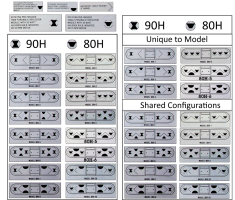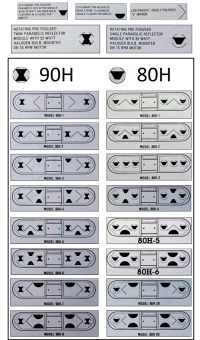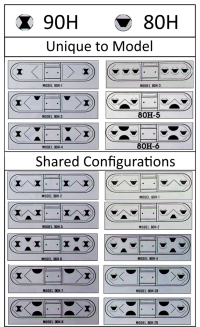Just curious what the differences are between the two. From what I know the 91h was an update or revision of some sort of the 90h. Also was a similar thing done to the 80h? Also another thing I haven't figured out was when was this series fazed out entirely. From what I've seen they appear to be decently effective bars, the problem was they were somewhat bulky expecially by early 90s standards. Were they ultimately replaced by the Advantedge?
You are using an out of date browser. It may not display this or other websites correctly.
You should upgrade or use an alternative browser.
You should upgrade or use an alternative browser.
What's the difference between the Whelen 90h series and 91h?
- Thread starter 1968
- Start date
JohnMarcson
Administrator
This is a really good question. The answer is kind of boring, but not to me obviously.....
Short answer is the model number change really only 100% corresponds to when they were being phased out; i.e. the timeline of when they were produced basically. Longer answer is sometimes the dome retainers and the open or closed end style of the domes are cited, although this doesn't 100% correlate; but it is very close. Near the end of the run of the product line the bars had open end (at the speaker) domes and some used larger retention rings at the ends. This was very close in time period to the model number change. Now take into consideration that Whelen was/is notorious for using older pics with new items (and vise versa) so that the catalog pictures and description don't match and you have a lot of possible overlap. The real answer is the model 81/91 was the phase-out model offered from 1987-1989 when less options were offered.
1985 the bars are called 80/90 and show the closed end domes.
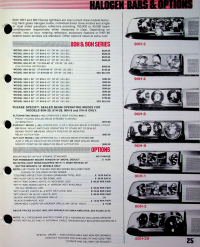

In 1986 the bars are still called 80/90 but show the open end dome style commonly associated with the change in name.
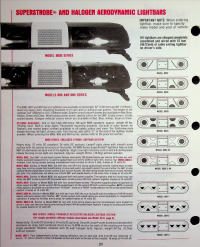

In 1987/88 the bars were called 81/91 and clearly have the open end dome style. The larger end clamp is not pictured. The page is basically reused from the previous year with a model the number change and a few less offerings listed.

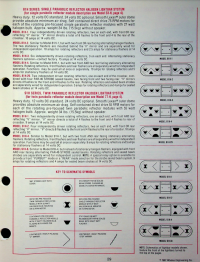
An example of the larger dome clamps that were used on some models.


1990, the bars are discontinued, the advantedge appears.

Short answer is the model number change really only 100% corresponds to when they were being phased out; i.e. the timeline of when they were produced basically. Longer answer is sometimes the dome retainers and the open or closed end style of the domes are cited, although this doesn't 100% correlate; but it is very close. Near the end of the run of the product line the bars had open end (at the speaker) domes and some used larger retention rings at the ends. This was very close in time period to the model number change. Now take into consideration that Whelen was/is notorious for using older pics with new items (and vise versa) so that the catalog pictures and description don't match and you have a lot of possible overlap. The real answer is the model 81/91 was the phase-out model offered from 1987-1989 when less options were offered.
1985 the bars are called 80/90 and show the closed end domes.


In 1986 the bars are still called 80/90 but show the open end dome style commonly associated with the change in name.


In 1987/88 the bars were called 81/91 and clearly have the open end dome style. The larger end clamp is not pictured. The page is basically reused from the previous year with a model the number change and a few less offerings listed.


An example of the larger dome clamps that were used on some models.


1990, the bars are discontinued, the advantedge appears.

Last edited:
kitn1mcc
Member
JohnMarcson
Administrator
Something to add to resurrect this thread; Whelen had a few common things they did.
I guess my point is with Whelen there is a lot of crossover with options, pictured options, and available vs. standard options.
- Reuse pictures from year to year incorrectly. This was so common that the edge pictured in the early 90s were never 100% their descriptions. They went from J tubes and old lenses to turbo tubes with new lenses by description, but the photos lagged so much they weren't right until an insert in a later catalog, less than a year before they changed design it not pictures again.
- Build anything you wanted if you ordered it and it fit
- Overlap options and option types. One example is the directional internal advantedge lights. You saw "gen 1" rotator heads as flashers in gen 3 bars, but also 4x3, halogens in gen 2 bars. I have an advantedge plus built with cadet rotators (essentially gen 1 brushed) and snap in bulb 700 series lights built at the same time as the 4500 replaced it, and after ballbearing delta style rotators were in use (4 rotator generations later). I have a gen 2 small dome responder bar with advantedge plus brushless gen 3 rotators built after the larger gen 3 responder dome was out.
- Reuse parts. Gen 1 responder rotators were 8000 series mini takedowns and advantedge alleys.
I guess my point is with Whelen there is a lot of crossover with options, pictured options, and available vs. standard options.
Last edited:
Does that mean that if I see a fluted lens on an Edge than it is at least a J-tube era? Also were the Edge 9000 bars in production after the introduction of the Ultra and 9M series or did they replace the 9000 on a dime. Also when the Advantedge hit the market, did Whelen can the previous models the day production on successors began their production? I've seen state troopers here in CT using Edge 9000s as late as 2013 or 2014. I think it's possible they still had special orders for big agencies for bars that were not still marketed anymore.Something to add to resurrect this thread; Whelen had a few common things they did.
These are big factors in identifying 80xx series bars. This came up when looking at adding par 46 strobes to a 90h. Using the rotator mounts from gen 1 responders with a blank inboard section was one way. Other times there were cutouts in the raised rotator plate instead of deleting it in favor of responder risers. I told someone that one was the old way, but then found bars that completely contradicted the timeframe. It seems either system was used, based on options maybe.
- Reuse pictures from year to year incorrectly. This was so common that the edge pictured in the early 90s were never 100% their descriptions. They went from J tubes and old lenses to turbo tubes with new lenses by description, but the photos lagged so much they weren't right until an insert in a later catalog, less than a year before they changed design it not pictures again.
- Build anything you wanted if you ordered it and it fit
- Overlap options and option types. One example is the directional internal advantedge lights. You saw "gen 1" rotator heads as flashers in gen 3 bars, but also 4x3, halogens in gen 2 bars. I have an advantedge plus built with cadet rotators (essentially gen 1 brushed) and snap in bulb 700 series lights built at the same time as the 4500 replaced it, and after ballbearing delta style rotators were in use (4 rotator generations later). I have a gen 2 small dome responder bar with advantedge plus brushless gen 3 rotators built after the larger gen 3 responder dome was out.
- Reuse parts. Gen 1 responder rotators were 8000 series mini takedowns and advantedge alleys.
I guess my point is with Whelen there is a lot of crossover with options, pictured options, and available vs. standard options.
JohnMarcson
Administrator
Does that mean that if I see a fluted lens on an Edge than it is at least a J-tube era? Also were the Edge 9000 bars in production after the introduction of the Ultra and 9M series or did they replace the 9000 on a dime. Also when the Advantedge hit the market, did Whelen can the previous models the day production on successors began their production? I've seen state troopers here in CT using Edge 9000s as late as 2013 or 2014. I think it's possible they still had special orders for big agencies for bars that were not still marketed anymore.
There are three basic edge lens types.
Heavy fluting top to bottom, (alley mounted on J-tubes)- J-tube (or a rare V style).
Non-optic center horizontal section, less fluting, (Alleys in a plastic "cage") - 9000 or post J tube pre 9M
Very lightly fluted, (alley mounted on end cap) - 9M, Ultra etc
The progression went 9000 (V, J, Turbo twist lock, and turbo linear), "E"/duplex, Ultra, and then 9M. There was lots of overlap, however there was a period in 2000/2001 where they only listed Ultra models. I think that went poorly, they quickly launched the 9M within a year and the "normal" size edge was back, they even refer to the "classic dimensions". However parts remained easy to obtain for most of the bars at least a generation later. I don't doubt that bars were produced for large orders after they were discontinued. There was crossover in the field, but moreover contradictions in catalogs. In their defense Whelen refined and updated products at a rate more common today than in the 80s and 90s. Today we get day 1 patches for software, and version numbers rack up fast for most things. Whelen was updating their products in little not-so-obvious ways frequently. Code 3 and Federal made product updates but usually in a way that didn't really make a new version, or in a way so major it was an announced advancement (strobe MX7000, Cuda Streethawk secondaries etc). To their credit Whelen kept up support of old products way longer than many companies. They also were pretty good with retrofitting instructions. There are PDFs still on their site telling you how to fit a LS or EB power supply into a bar with older ones.
The thread linked below has some similar but more in-depth reflector info. I have since corrected some dates by a year or two, but again, overlap. I will post some contradictions and confusion points in this thread.
Whelen Edge evolution
I was curious about the history and technical evolution of the whelen edge lightbar platform. I know that multiple generations existed from it's inception in 1983 thought to 9M and freedom LED lightbars of the 2000s and 2010s. There isn't a whole lot about it technically like there is for...
Looking at the edge as a whole, the progression was pretty straightforward. It was the number of lingering options that looked very similar that were confusing IMHO (and the incorrect catalogs).
From 1984-1999 this is the real world progression and the symbols used to represent components.
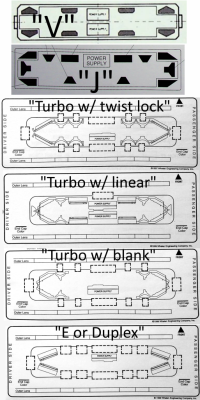
1987 debuted the "J" or "combo directional / 180" corner to replace the two-ish year run of the "V"
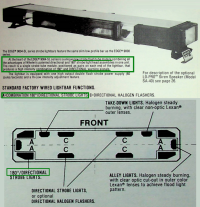
Yet in 1988 the drawings, descriptions, and pics don't match. "V" and "J" were both common in the field at that time.
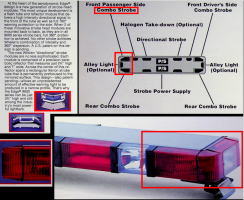
In 1992 we got a color insert explaining the new lenses and "turbo tubes" (pictured correctly), but that year's catalog containing the insert had the new lenses, updated text, but old "J" tubes "guts".
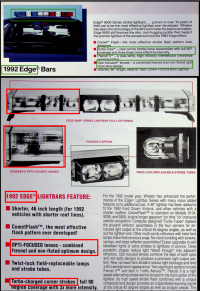
The incorrect "J Tube guts" pics got reused for a few years. The 1993, 1994, and at least 1995 catalogs all carried over the photos.
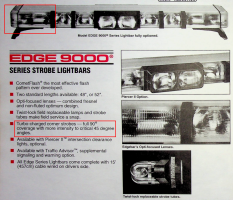
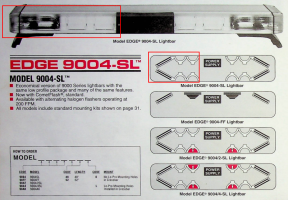
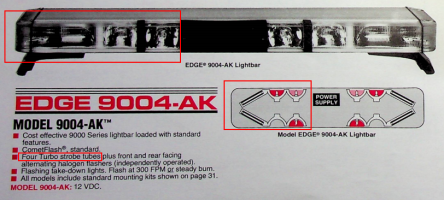
In 1997 the reflector was the linear inboard which was offered alongside the "E" or duplex. The drawings didn't reflect it, showing just twist lock. The pics showed both.
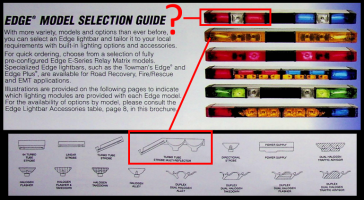
In 2000/2001 the Ultra is the only non-LFL sized edge, but it has "duplex" options, and they reused the duplex picture of the 1997 duplex E series as the top title image. The 9M isn't mentioned.

In 2002 the Ultra AND 9M are offered, both with duplex options in the form of split 400 series heads. basically pic your width, snap the tabs off the corner tubes to suit your frame, and fill the bar with anything offered in 400 series.
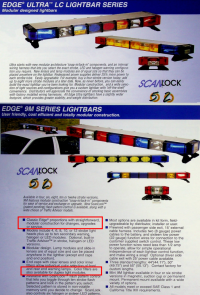
After that the LED bars show up with the word "edge" in front of the names we know them by now. But that is pretty much the progression. The only real one of note was the 9308 NFPA which used 5mm 700 series LEDs, just before or right around when the Freedom launched, but lacked an NFPA sized bar. So that made an all LED 9000 series edge, whereas other edge bars using LEDs were freedom, ultra, LFL, or 9M. The 9000 series died last in the NFPA and "special" markets.

Last edited:
JohnMarcson
Administrator


